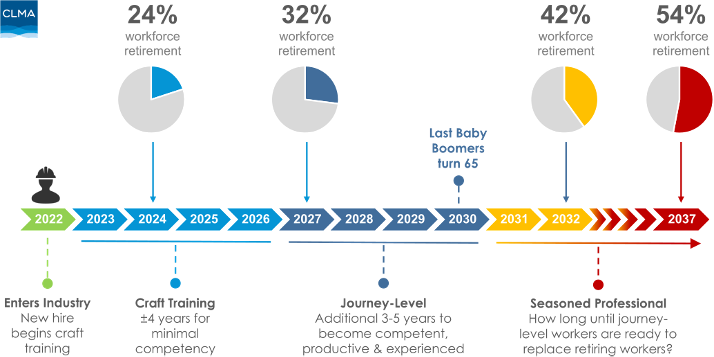Apprenticeship Programs Can’t Do It Alone
In recognition of National Apprenticeship Week, November 14-20, The National Center for Construction Education & Research (NCCER) congratulates all apprentices currently training in the United States to become construction craft professionals. However, as the construction workforce ages, the industry is at a critical crossroads.

Source: Construction Labor Market Analyzer, 2022.
Here are three additional observations.
1. Journeyman = Bachelor’s Degree
It takes about the same amount of time for apprentices in the construction trades to reach journeyman level as it does for a college student to earn a bachelor’s degree. For example, it takes three to five years to become a journey-level pipefitter, four to five years to become an electrician, and four years to become an ironworker. Likewise, an additional three to four years of training and testing is needed for a journeyman to become a master craftsperson, much like the student pursuing a post-graduate degree.
Simple acknowledgement of this should increase the perceived value of choosing a career as a craft professional to parents, educators, and others who influence a young person’s career choices. Unfortunately, this information has not been widely presented, and therefore most people do not initially choose an apprenticeship path following high school.
Another benefit that is not well known are the multiple pathways available for individuals to advance to senior management. As shown in NCCER’s interactive career pathways chart, apprenticeships provide similar career advancement opportunities to those with college degrees, and, in fact, more people in the construction industry go from an entry-level job to CEO or owner of their own company than any other industry.
2. Accounting for a Four-Year Lag
The average age of a construction apprentice in the U.S. is 29, while most undergraduate students are under the age of 25. That is an indication that it takes almost twice as long for individuals to decide to enter the construction trades and start their training. Construction industry research over the years has shown that one of the prime drivers for this age disparity is that many individuals come to construction after first trying other career paths.

At age 18 when faced with the next step after high school, going into training in the construction trades is not often a first choice. Entering college, joining the military, or even going straight to work with no specific post-secondary training causes a detour on an individual’s path to the trades.
One reason is the lack of understanding about the overall labor market. According to the Bureau of Labor Statistics, only 28% of future jobs are expected to require a four-year degree. In fact, industry research shows that for every 10 new jobs that are produced in the United States, only one will require an advanced degree, two will need a bachelor’s degree, but seven of the jobs will require a technical degree, apprenticeship, or industry-recognized credential. It’s also worth noting that the public is generally unaware of the average annual salaries for various journey-level craft professions.

Source: BLS Reference
A new tool released this year by NCCER is designed to shorten that lag. CareerStarter is an online platform that brings together job seekers, educators, and employers. The Career Exploration feature enables job seekers to find the right career through a personal interest quiz and helps them connect with nearby training programs and ultimately employers willing to hire them for entry-level job openings.
3. Expanding the Apprenticeship Model
Work-based learning, including internships and co-ops, needs to be a more significant part of the U.S. education system. According to the U.S. Department of Labor (DOL), there were more than 593,000 apprentices registered with the Bureau of Apprenticeship and Training in 2021. Of these, 197,421 participate in registered construction apprenticeship programs. This falls well short of the projected construction craft professional shortage of 1.9 million by 2025.
One of the reasons that we don’t have more “registered” apprenticeship programs is the amount of bureaucracy and the administration burdens imposed by the DOL, including rigid time requirements for classroom training that may not always coincide with project schedules or an individual’s competencies.
To support and expand the apprenticeship model, these changes need to be made.
- Increase the number of DOL representatives to provide guidance for existing programs and assist in developing new ones at the U.S. state level.
- Incentivize companies and corporations to invest in their workforce by establishing apprenticeship training programs and/or hiring apprentices into their workforce.
- Factor in competency-based training into work-based learning. This provides apprentices the opportunity to receive program credit for demonstrated skills similar to advanced placement testing for university credit.
- Expand Title IV funding (Pell grants, Perkins Bill) to apply to industry-recognized, accredited technical schools.
- Leverage governmental tax incentives to increase investment in career and technical education.
We need to simplify the workforce development system in this country to remove barriers and increase participation in all apprenticeship programs. In 2018, NCCER along with other industry partners, released a three-year research document on this complex topic. We recommended three short-term and four long-term policy changes that industry, education, and government could tackle to make a difference. Download the research, advocacy document, and slide presentation here.
More Resources from NCCER
In October, NCCER launched a podcast called “The Builder’s Table.” Airing weekly on Mondays, it features construction professionals discussing critical topics such as solutions to workforce issues. During National Apprenticeship Week, the podcast guest is Brady Woodel, an ABC apprentice who was recently on Fox news discussing the earn-while-you-learn apprenticeship model. Tune in on Monday, Nov. 14 as Jennifer Wilkerson, NCCER’s Vice President of Innovation and Advancement, talks with Woodel. The Builders’ Table is available on several services including Apple Podcasts, Spotify, Amazon Music and more.
In addition, there is still time to register for the 2022 Construction Career Pathways Conference, November 30 in Las Vegas, NV. Get registered here.
Interested in receiving more great construction news, research and content from NCCER? Click here to join our mailing list!

